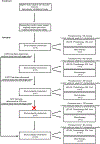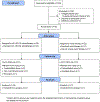Safety of light emitting diode-red light on human skin: Two randomized controlled trials
- PMID: 31483941
- PMCID: PMC8887049
- DOI: 10.1002/jbio.201960014
Safety of light emitting diode-red light on human skin: Two randomized controlled trials
Abstract
Therapeutic applications of light emitting diode-red light (LED-RL) are expanding, yet data on its clinical effects are lacking. Our goal was to evaluate the safety of high fluence LED-RL (≥160 J/cm2 ). In two phase I, single-blind, dose escalation, randomized controlled trials, healthy subjects received LED-RL or mock irradiation to the forearm thrice weekly for 3 weeks at fluences of 160-640 J/cm2 for all skin types (STARS 1, n = 60) and at 480-640 J/cm2 for non-Hispanic Caucasians (STARS 2, n = 55). The primary outcome was the incidence of adverse events (AEs). The maximum tolerated dose was the highest fluence that did not elicit predefined AEs. Dose-limiting AEs, including blistering and prolonged erythema, occurred at 480 J/cm2 in STARS 1 (n = 1) and 640 J/cm2 in STARS 2 (n = 2). AEs of transient erythema and hyperpigmentation were mild. No serious AEs occurred. We determined that LED-RL is safe up to 320 J/cm2 for skin of color and 480 J/cm2 for non-Hispanic Caucasian individuals. LED-RL may exert differential cutaneous effects depending on race and ethnicity, with darker skin being more photosensitive. These findings may guide future studies to evaluate the efficacy of LED-RL for the treatment of various diseases.
Keywords: low-level light therapy; phototherapy; randomized controlled trial; skin pigmentation.
© 2019 WILEY-VCH Verlag GmbH & Co. KGaA, Weinheim.
Figures





Similar articles
-
A single-blind, dose-escalation, phase I study of high-fluence light-emitting diode-red light on Caucasian non-Hispanic skin: study protocol for a randomized controlled trial.Trials. 2019 Mar 20;20(1):177. doi: 10.1186/s13063-019-3278-7. Trials. 2019. PMID: 30894210 Free PMC article.
-
A single-blind, dose escalation, phase I study of high-fluence light-emitting diode-red light (LED-RL) on human skin: study protocol for a randomized controlled trial.Trials. 2016 Aug 2;17:385. doi: 10.1186/s13063-016-1518-7. Trials. 2016. PMID: 27484782 Free PMC article. Clinical Trial.
-
A dose-ranging, parallel group, split-face, single-blind phase II study of light emitting diode-red light (LED-RL) for skin scarring prevention: study protocol for a randomized controlled trial.Trials. 2019 Jul 15;20(1):432. doi: 10.1186/s13063-019-3546-6. Trials. 2019. PMID: 31307501 Free PMC article.
-
Visible Red Light Emitting Diode Photobiomodulation for Skin Fibrosis: Key Molecular Pathways.Curr Dermatol Rep. 2016;5:121-128. doi: 10.1007/s13671-016-0141-x. Epub 2016 Apr 16. Curr Dermatol Rep. 2016. PMID: 27182462 Free PMC article. Review.
-
Retrospective analysis of the treatment of melasma lesions exhibiting increased vascularity with the 595-nm pulsed dye laser combined with the 1927-nm fractional low-powered diode laser.Lasers Surg Med. 2017 Jan;49(1):20-26. doi: 10.1002/lsm.22518. Epub 2016 Apr 13. Lasers Surg Med. 2017. PMID: 28134994 Review.
Cited by
-
Red Light Phototherapy Using Light-Emitting Diodes Inhibits Melanoma Proliferation and Alters Tumor Microenvironments.Front Oncol. 2022 Jun 24;12:928484. doi: 10.3389/fonc.2022.928484. eCollection 2022. Front Oncol. 2022. PMID: 35847848 Free PMC article.
-
Visible light. Part I: Properties and cutaneous effects of visible light.J Am Acad Dermatol. 2021 May;84(5):1219-1231. doi: 10.1016/j.jaad.2021.02.048. Epub 2021 Feb 25. J Am Acad Dermatol. 2021. PMID: 33640508 Free PMC article. Review.
-
Outstanding user reported satisfaction for light emitting diodes under-eye rejuvenation.Arch Dermatol Res. 2024 Aug 12;316(8):511. doi: 10.1007/s00403-024-03254-z. Arch Dermatol Res. 2024. PMID: 39133416
-
Reverse skin aging signs by red light photobiomodulation.Skin Res Technol. 2023 Jul;29(7):e13391. doi: 10.1111/srt.13391. Skin Res Technol. 2023. PMID: 37522497 Free PMC article.
-
The Influence of Popular Media on Public Interest in Red-Light Therapy: Longitudinal Trend Analysis.JMIR Dermatol. 2025 Jun 12;8:e69796. doi: 10.2196/69796. JMIR Dermatol. 2025. PMID: 40504616 Free PMC article.

